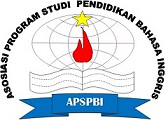EXPLORING SHARING TIME INTEGRATION IN EFL CLASSROOM FOR YOUNG LEARNERS
Abstract
Keywords
Full Text:
PDFReferences
Budiningsih.C., A. (2005). Belajar dan Pembelajaran. Jakarta: Rineka Cipta.
Cook-Gumperz, J. (1986). The social construction of lite. cambridge: cambridge University
press.
Dewi, S. L. (2014). Improving Speaking Achievement Using Sharing Time At the Sixth
Semester Students of English Department of Almuslim University. 2007, 784–788.
Fitriani1, A., Adjie2, N., Dewi3, F., & Risty Justicia4. (2019). STUDI KASUS
PERKEMBANGAN KETERAMPILAN BERBICARA ANAK USIA DINI MELALUI
PENERAPAN METODE BERCERITA PENDAHULUAN Bahasa merupakan salah
satu aspek perkembangan yang harus cara yang menyampaikan orang lain .
keinginannya Seperti pada keterampilan lainnya , an. Jurnal Pelita PAUD, 29–37.
Hannah, A. (2015). THE IMPACT OF SHARING TIME ON COMMUNITY-BUILDING AND
ACCESS TO SCHOOL-BASED LITERACY.
Kelly, B. (1999). ‘Circle Time’: A systems approach to emotional and behavioural
difficulties. International Journal of Phytoremediation, 15(1), 40–44.
https://doi.org/10.1080/0266736990150107
Kiswoyowati, A. (2011). Edisi Khusus No. 1, Agustus 2011. Portal Jurnal Universitas
Pendidikan Indonesia, 1, 120–126.
Lown, J. (2002). Circle Time: The perceptions of teachers and pupils. International Journal
of Phytoremediation, 18(2), 93–102. https://doi.org/10.1080/02667360220144539
Meister, D. G., & Melnick, S. A. (2003). National New Teacher Study: Beginning Teachers’
Concerns. Action in Teacher Education, 24(4), 87–94.
https://doi.org/10.1080/01626620.2003.10463283
Purnamaningsih, E. H. dkk. (2003). Kepercayaan Diri Dan Kecemasan Komunikasi
Interpersonal Pada Mahasiswa Fakultas Ekonomi Di UKRIM Yogyakarta. Jurnal
Psikologi, 2(2), 67–71.
Rahina, N. (2007). Media Pembelajaran Berbasis Visual Berbentuk. Lembaran Ilmu
Kependidikan Jilid 36 No.1, 35–44.
Spence Rogers, L. R. (1999). By focusing on fulfilling fundamental emotional needs,
teachers can enhance students’ motivation to learn. Educational Leadership, 43-45.
Stankov, L., Morony, S., & Lee, Y. P. (2014). Confidence: The best non-cognitive predictor
of academic achievement? Educational Psychology, 34(1), 9–28.
https://doi.org/10.1080/01443410.2013.814194
T soendari. (2012). Metode penelitian deskriptif. 50–61.
Ufie, A., Kualitatif, P., Nugrahani, F., Parupalli, S. R., Nteli, A., Zafiri, M., Kolokytha, E.,
Loutrouki, S., Valsamidis, S., Florou, G., Nursalam, 2016, metode penelitian, Okada,
Y., Sawaumi, T., Ito, T., Erasmus, N., Overwater, I. E., Parupalli, S. R., Miskam, N. N.,
Saidalvi, A., … Saebani. (2014). dalam Penelitian Pendidikan Bahasa. 信阳师范学院,
(1), 32. https://doi.org/10.1016/j.sbspro.2015.04.758
Wahyuni, S. (2014). Hubungan Antara Kepercayaan Diri Dengan Kecemasan Berbicara Di
Depan Umum Pada Mahasiswa Psikologi. Jurnal Psikologi, 2(1), 50–62.
Yazigi, R., & Seedhouse, P. (2005a). “Sharing Time” with Young Learners. Tesl-Ej, 9(3), 1–
DOI: http://dx.doi.org/10.20527/jetall.v4i1.8743
Article Metrics
Abstract view : 389 timesPDF - 270 times
Refbacks
- There are currently no refbacks.
This journal is indexed in:


This Journal is listed in:
 Journal of English Teaching, Applied Linguistics and Literatures (JETALL)
Journal of English Teaching, Applied Linguistics and Literatures (JETALL)








.png)



1.png)
